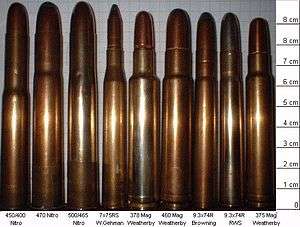.450/400 Nitro Express
The .450/400 Nitro Express is a Nitro Express rifle cartridge that is produced in two case lengths, 2⅜-inches and 3¼-inches,[2] and is intended for use in single shot and double rifles. The latter is considered a classic Nitro Express cartridge.
| .450/400 Nitro Express (3¼-inch) | ||||||||
|---|---|---|---|---|---|---|---|---|
 .450/400 3¼ inch Nitro Express in a line up. | ||||||||
| Type | Rifle | |||||||
| Place of origin | United Kingdom | |||||||
| Production history | ||||||||
| Designer | Kynoch, Jeffery, and others | |||||||
| Designed | 1899 | |||||||
| Manufacturer | Various | |||||||
| Produced | 1899 to present | |||||||
| Specifications | ||||||||
| Parent case | .450/400 Black Powder Express | |||||||
| Case type | Rimmed, bottlenecked | |||||||
| Bullet diameter | .405 in (10.3 mm) | |||||||
| Neck diameter | .432 in (11.0 mm) | |||||||
| Shoulder diameter | .502 in (12.8 mm) | |||||||
| Base diameter | .544 in (13.8 mm) | |||||||
| Rim diameter | .614 in (15.6 mm) | |||||||
| Rim thickness | .042 in (1.1 mm) | |||||||
| Case length | 3.25 in (83 mm) | |||||||
| Overall length | 3.85 in (98 mm) | |||||||
| Primer type | Kynoch #40 | |||||||
| Ballistic performance | ||||||||
| ||||||||
| Test barrel length: 26 inches Source(s): Kynoch[1] & Barnes[2] | ||||||||
Development
Both the .450/400 2⅜-inch NE and .450/400 3¼-inch NE were created by loading the .450/400 Black Powder Express cartridges of both case lengths with smokeless cordite.
.450/400 2⅜-inch Nitro Express
The .450/400 2⅜ inch Nitro Express was loaded with a 400 gr. RN bullet with 42 or 43 grains of cordite and was meant for use in newer rifles chambered for the .450/400 2⅜ inch case as this loading generates greater pressure than the Black Powder Express versions of the cartridge.
.450/400 3-inch Nitro Express
This cartridge is better known as the .400 Jeffery Nitro Express.
.450/400 3¼-inch Nitro Express
The .450/400 3¼-inch NE conversion was not initially entirely successful, under the increased pressures of the cordite loading the long neck could stick in the chamber causing the rim to pull off at extraction,[2] a problem not encountered under the milder black powder loadings. To counter this, the rim was increased in thickness to .042-inches. W.J. Jeffery & Co further improved the cartridge by reducing the length of the case to 3-inches and moving the neck further forward, creating the .450/400 3-inch NE.
Additionally, the caliber had to be standardised, slight variations existed in both the rifles and the low-pressure black powder cartridges produced by different manufacturers, the bullet diameter is nominally given as .405 inches, bore as large as .411 existed, not a significant problem in black-powder rifles. In Nitro Express loadings, an undersized bullet in an oversized bore may experience accuracy issues while an oversized bullet fired in an undersized bore may cause a catastrophic failure in the firearm.[2]
The .450/400 3¼-inch Nitro Express fires a 400 gr. jacketed bullet ahead of a charge of 56 - 60 gr. of cordite at a velocity of 2,150 ft/s (660 m/s). This cartridge is considered unsafe to use for older rifles chambered for the black powder version of this cartridge due to higher pressures generated by this loading. .450/400 3¼-inch Nitro Express rifles are heavier and were considered as the minimum cartridge necessary when hunting dangerous game.
Use
The .450/400 NE in both the 3-inch and 3¼-inch versions were extremely popular in Africa and India, prior to the introduction of the .375 Holland & Holland they were considered the best all-round African hunting caliber. Both cartridges were extremely popular in India with Maharajas and British sportsmen for hunting tiger.[3]
In his African Rifles and Cartridges, John "Pondoro" Taylor stated the 3-inch and 3¼-inch .450/400 NE were adequate for all African game in almost all conditions when used by an experienced hunter.[4]
See also
- Nitro Express
- List of rifle cartridges
- 10 mm caliber other cartridges of similar caliber size.
References
Footnotes
Bibliography
- Barnes, Frank C, Cartridges of the World, ed 13, Gun Digest Books, Iola, 2012, ISBN 9781440230592.
- Kynoch Ammunition, Big Game Cartridges kynochammunition.co.uk
- Roberts, Paul, Nitro big game rifles, retrieved 13 Nov 15.
- Taylor, John, African rifles and cartridges, Sportsman’s Vintage Press, 2013, ISBN 978-1-940001-01-2.